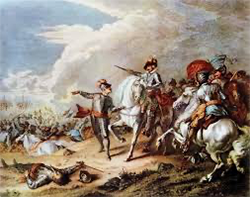The English Civil Wars
In 1643, the two sides did come to blows at various points:

The next phase featured the Solemn League and Covenant, an alliance between the parliamentary force and a Scottish army, led by the Earl of Leven. The alliance eventually turned the tide in favor of the Parliamentarians. The Roundheads had claimed victory at Nantwich in January. The Scottish invaders seized the city of Newcastle-on-Tyne the following month. The Roundheads scored a victory at Cheriton in March. The Royalists under Prince Rupert stormed back viciously at Bolton in May, and the Charles-led Cavaliers won again at Cropredy Bridge the following month. However, the Roundhead-Scotland coalition was at full strength at Marston Moor, in July, and scored a decisive victory, resulting in Charles's abandoning the north altogether. The Royalist victory at Aberdeen in September was the a minor success. The two sides fought again at Newbury, in October, and the result was another standoff. In 1645, Parliament formed the New Model Army, a professional military force led by Cromwell and Thomas Fairfax. The parliamentarian leaders were having increasing difficulties convincing their militias to fight if it required roving too far from home. The strategy of using militias local to the area of the fighting had worked so far, but as the fighting ranged far and wide, the Roundheads, in particular, were having trouble raising recruits. The New Model Army offered daily pay and required its members to drill, train, and fight when told. The numbers swelled to 22,000 and were more than the Cavaliers had at their disposal at this point. The first pitched battle of 1644 didn't occur for many months. Not until May did the two sides come to blows in a meaningful way, and the Royalists claimed victory at Auldearn. The next battle was a very significant victory for the Parliamentarians. At Naseby, Charles lost most of his veteran officers and infantry and all of his artillery. For all intents and purposes, this was the last gasp for the king. He still had various regiments scattered about the kingdom, but his losses were starting to mount and he was unable to find anything or recruit anyone of the caliber of what he had just lost. A few minor battles followed. The Royalists won at Alford in July. In the same month, however, the Roundheads won at Langport and gained control of the West of England. Another Scottish battle, Kilsyth, went the way of the Royalists in August. The reverse was true fat Philiphaugh in September. And at the end of the month, Charles suffered yet another defeat at Rowton Heath. As a result of that battle, the Royalist garrison surrendered Chester in February 1646. (This followed the Royalist surrender of Dartmouth in January.) The New Model Army inflicted more damage at Torrington, Tresillian, and Stow-on-the-Wold. When the Royalist garrison at Exeter surrendered, so did Charles. The king gave himself up not to Cromwell and Parliament but to Scotland. The Scottish handed over the king to Parliament for a large ransom in January 1647. In the meantime, however, the fighting continued, with further Royalist garrisons surrendering at Oxford in June, Worcester and Wallingford Castle in July, Raglan Castle in August, and Harlech Castle in March 1647. 
Parliamentary forces kept the king under house arrest. Charles escaped to the Isle of Wight, in hopes of raising a new army and reversing his recent fortunes. He was successful at the former but not the latter. The Second English Civil War had the same result as the First, in a shorter period of time. Charles finally got his alliance with Scotland, and a Scottish invasion force entered the scene in 1648. At St. Fagans in April, the New Model Army continued its winning ways, adding to that a victory at Maidstone in June. The Royalist garrison in Pembroke surrendered in July. The final victory for the Parliamentarians was effectively the Battle of Preston, in August. The Royalists surrendered at Colchester not long afterward, and the Second Civil War ended the same way the First one did. The parliamentary forces turned their sights on Parliament and convinced all of the remaining supporters of the king to leave. What was left was called the Rump Parliament. The House of Commons convened a high court of justice in January 1649. The verdict was that Charles was guilty of treason. The sentence was death and was carried out on January 30. The fighting wasn't finished for the New Model Army. Forces in Ireland had rebelled, and Cromwell and Admiral Robert Blake led an English force into Ireland to put down a rebellion. In what came to be called the Third Civil War, Cromwell and his forces then sailed back to England, to the north, to confront an alliance of Scottish soldiers and the late king's son, also named Charles. Cromwell's forces won a decisive victory at Dunbar in September 1650 and then occupied Scotland. The fighting continued into 1651, with Cromwell's forces winning again, at Inverkeithing in July, at Wigan and Upton (back in England) in August. The final battle of the war was at Worcester in September, and the New Model Army's superior numbers and tactics were more than a match for Charles and his defenders. The would-be Charles II fled to France.The government of England and Scotland, meanwhile, passed to a Commonwealth (in 1649) and then a Protectorate (1653–1658). Estimates are that nearly 85,000 soldiers died in the English Civil Wars, 34,000 on the Parliament side and 50,000 on the king's side. In addition, war-related disease are thought to have killed another 100,000 people. Next page > Background > Page 1, 2, 3 |
|
Social Studies for Kids
copyright 2002–2024
David White




